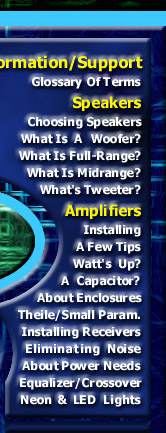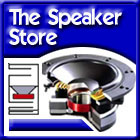




Technical
Help
& Education
Glossary Of Terms
Speakers Main Page
How Speakers Work
Choosing Speakers
What's A Woofer?
What's A Midrange?
What's A Tweeter?
Other Speaker Types
More Speaker Types
What's A Capacitor?
Installing A Capacitor
What's A Crossover?
What's An Equalizer?
Speaker Enclosures
Theile/Small Param.
About Power Amps
Installing An Amp
Installation Tips
Power Ratings
Installing/Replacing
Head Units/Receivers
Installing Neon/LED
Eliminating Noise
Use The Right Tools
Manufacturer's
Links
Personal
& Marine
Electronics
Laptop Computers
Cell Phones & PDAs
Portable TV & Video
Electronic Readers
MP3/Music Players
CD
Players/Booms
Earphones/Buds
Digital Cameras
Video
Cameras
Personal GPS
Bluetooth
Calculators
Accessories
Marine
Electronics
Stereo Amplifiers
Stereo Speakers
Stereo Woofers
Enclosed Speakers
TVS & Video
CD/Mp3 Receivers
GPS & Navigation
Fish Finders
Accessories
Home
Stereo &
Office Electronics
Flat
Screen & HD TVs
Surround Sound
Home Theater
DVD Players/Tivo
DVD Recorders
Blu-Ray Devices
Amplifiers/Tuners
Speaker
Systems
Subwoofer Drivers
Midrange
Drivers
Tweeter Drivers
Powered Subwoofers
Outdoor
Speakers
Stereo Accessories
Digital
Photo Frames
Video Game Systems
Game
Accessories
Video Games
Home Security/Alarms
Computer
Products
Desktops & Laptops
Add-Ons/Peripherals
Computer Monitors
Computer Software
Computer Games
Printers &
Scanners
Ink/Specialty Papers
Parts & Components
Computer Supplies
Security/Tech
Support
Auto
Electronics
Amplifiers
Subwoofers
Full-Range Speakers
Midrange Speakers
Tweeters
Power Capacitors
Empty
Enclosures
Loaded Enclosures
CD/Mp3 Receivers
CD Changers
Bass Packages
Car
TV & Video
Satellite
Radio
Bluetooth Wireless
GPS Navigation
Neon/LED Lighting
Radar Detectors
Chrome
Mufflers
Car Alarms/Security
V
AUTO
PARTS STORE
Auto
Wiring &
Accessories
Air Horns
Power
Antennas
Antenna Boosters
A/V Controllers
Bass Blockers
Crossovers
Dynamat
Equalizers
Fans (Cooling)
FM Modulators
Interfaces
Line Converters
Noise Filters
Power Inverters
Power Supplies
RCA Cables
RCA Splitters
Remote Controls
Signal Boosters
Vibration Control
Speaker Grills
Wiring Kits
Understanding
Amplifier Power Ratings
Watts appear to be an easily understood figure that conveys a reasonable picture of how powerful an amplifier is at a glance. Or so it would be if the "kick it up a bit" marketing boys had not gotten to it. Back in the old days (1982) It was FTC mandated, for the manufacturer to provide a comprehensive single criteria, power specification. However, with the de-regulation craze of the 80's, this requirement was dropped in favor of, " that old marketplace magic." This basically means "caveat emptor" rules. We will do our best here to give you some basis for judgment, however.
There
are a number of terms that apply to descriptions of a unit's power output
as stated in watts.
A watt itself is a unit of energy that can be correctly described as
the power used when energy is expended at the rate of one joule per
second. A Joule is a quantity of work or heat that is generated equivalent
to the force of one Newton moving an object at the point of application,
a distance of one meter.
Now this wonderfully concise physical description can be as well applied
to the actions of amplifiers upon their loads (speakers) as it can to
any other phenomenon. When electrical power generated by the amplifier
is applied to a load to do work, (move a cone back and forth) the resulting
energy expenditure can be uniformly measured in a standard way, and
applied to all other similar situations.
There
is only one comparative power designation that is truly helpful, and
that is:
RMS
Which
stands for
R
oot
M
ean
S
quare, the only
reasonably accurate, consistent, comparative measurement of power exchange
that should be used for both amplifiers and speakers. RMS is an average
of the power transfer between a generator and normative load that is
obtained by measuring the AC power with the formula P=EI cosine O
where cos. O is the power factor.
Generally( but not always), RMS is half or less of the value usually
attributed to alternative methods such as:
Peak power
Max power
IPP - Instantaneous Peak Power
PMPO - Peak Music Power Output
and other measurement methods, that while having a nebulous mathematical
consistency, are still little more than schemes to create higher numbers
to increase sales. Some manufacturers of low price components have recently
taken to promoting power figures of as much as 10 times the RMS specification.
Be wary ...very wary!
Many manufacturers provide specifications without mentioning what kind
of watts are being measured. Again, this almost always means that those
are not RMS watts, and the actual power is half or less (often, much
less) than the number indicated.
Where
are Watts Found
It is important to remember that amplifiers create an amount of electrical
potential that does not become watts untill the energy is converted
to another form. This happens in the speaker, where the voice coil consumes
watts of electrical energy as it converts it to sound amplitude as measured
in decibels.
Multiple
power points
Another favorite trick is to just throw out a number for woofers with
two voice coils or amplifiers with 2 or 4 channels. This invariably
turns out to be the maximum watts for all functions. So:
"300 MAX watts Four Channel Amplifier" really means 150 watts
RMS divided into four channels or 37.5 watts RMS per channel. Often
it can mean less. Decidedly less impressive, eh? Or, for a woofer, "400
watt dual voice coil woofer" really means 200 watts RMS divided
by two coils or 100 watts RMS per coil. This could yield disappointing
results. Unfortunately, these descriptions are not always consistent.
If they were, it would be easier for consumers to pin them down.
Bridging
But that's not all! There are plenty more complications where these
came from. For instance in amplifiers, there are amps with not only
multiple channels, but the capability of being bridged. This means that
any two ( but only two) channels can be bridged to form an amplifier
of approximately double the capacity of a single channel. It does this
by taking a mono input signal and dividing it between the positive peaks
of the signal and the negative valleys, and amplifying each separately.
These separated polarities are then reunited at the amplifier terminals
to form a unified signal again for the woofer.
Thus, two 75 watt RMS amplifiers can become a single 150 watt RMS amp.
In a four channel bridgeable amplifier, four can be come two, each with
twice the power of a single channel.
But look out here! Most amplifiers are of the class AB variety. this means they can be bridged to a 4 ohm load only, yet some brands advertise the total of the 2 ohm load each channel can carry separately. This is very misleading and should not be confused with the amplifiers described in the next paragraph.
Multiple
power ratings
Increasing numbers of amplifiers, particularly monoblock, high current
or digital models, have the capacity to handle low impedance loads,
sometimes all the way down to one ohm. As the impedance figure goes
down, the wattage figure goes up. This reflects the fact that efficiency
increases as the load becomes heavier (ohms figure gets smaller) Consequently,
the greatest efficiency can be realized with amplifiers capable of delivering
stable operation into very low impedance woofer circuits.
While 4 ohm remains the industry standard for many car amps and single
coil woofers, capacities are tending downward, mostly because of the
increase in the watt numbers attendant to lower impedance carrying ability.
At a minimum, better quality units will list "2 ohm Stable"
as a feature. Since most speaker loads are highly variable in operation,
and will have occasions when operational impedance of a 4 ohm system
can go below 2 ohms, it is good to have this capacity so that distortion
is reduced at high amplitudes, especially.
Dual voice coil woofers can have coils that are 1, 2, 3, 4, 6, and 8
ohms. This means that such woofers can be configured to operate either
singly or separately at the most efficient level. These woofers can
be connected in a variety of ways to the multiple impedance amplifiers.
Dual voice coils can be connected either in parallel or serial circuits.
A woofer with two 4-ohm coils connected serially would produce an 8-ohm
total, or in parallel (with both + terminals and both - terminals tied
to one set of amplifier terminals) a 2-ohm load. Of course, a single
voice coil can be used also, albeit at half the rated power. Check our
Impedance
Calcultor
to get it right.
With two woofers connected in a serial circuit, two 2-ohm woofers can
present a 4 ohm load, or two 1 ohm woofers can present a 2 ohm load.
The
best common configuration
is
to use two dual voice coil woofers with 4 ohm coils. All four coils
in parallel will make a highly efficient 1 ohm load, with power handling
equal to the total RMS of both woofers.
But in all cases, the idea is to match both the impedance and the output
power capacity of both the amp and woofer units. A good relationship
is for the Amplifier to supply between 10 to 40 percent more power to
the woofer than the woofer's nominal RMS watt handling rating. Thus,
a 200 watt woofer should optimally have a 225 to 280 watt amplifier
channel connected to it.
But remember that all watt indications above are .... (what kind?)
....RMS, that's right.
Unfortunately,
there are other ways in which watt measurements are taken that lend
themselves to the kind of exaggeration and hyperbole that creates so
much confusion for shoppers and owners of such equipment. Let us examine
a few ways in which test conditions make it possible for manufacturers
to make doubtful claims:
The power supply
All amplifiers will be able to supply larger waveforms when higher than
usual voltages are applied to them. An amplifier that produces 200 watts
at a normal 12 -13.5 volts may produce up to 300 watts when the power
is boosted to 15 volts. Of course such an arrangement does not obtain
in too many cars, and it is stressful on the amplifier, but that does
not stop some sellers from using it.
Number of operating channels
When power is measured on a channel with only that channel operating,
the resulting watts will be substantially higher than if all channels
are operating and loading the unit's power supply uniformly - the condition
in which most people operate their system.
Unspecified load factors
Some makers will use lower resistance than customary for obtaining power
measurements, that is, a very low resistor value from half an ohm to
2 ohms and this is presented as the un-attributed, presumably standard
impedance value. The value for the advertising cheat of not saying anything,
is that the reader tends to presume everything.
Biased testing factors
Differences in ambient temperature, the amount of total harmonic distortion
(THD) produced, and tested frequency bandwidth can also impact the number
of RMS watts that can be produced. For instance a 250 watt amplifier
operated to extreme capability will produce 500 watts RMS, but only
with 18 percent distortion. While people are more tolerant of high distortion
than is generally realized, this amount would be painfully unacceptable
to most.
Get
help Here!
If you are uncertain of how to match your amplifier to the proper
woofers, or vice versa, contact us through the "
Ask
Experts
" page. Let us know the brand and models you have, or
are considering, and we will check the compatibility, and sugggest alternatives
if necessary.
Or...
Check
our Easy selection System
See
our high power Woofer Selector
Here
.
Once you have selected a woofer or two, go to the amp selector to
Find a Compatible Amplifier
Here
MAIN
PAGE
GLOSSARY
SPEAKERS:
Choosing
General
Woofers
Miidrange
Tweeters
Full-Range
Full-Range 2
CAPACITORS
CROSSOVERS
EQUALIZERS
Theile/Small
AMPLIFIERS:
About
Installing
Install Tips
Power Ratings
RECEIVERS:
Installing
NEON/LED:
Installing
TOOLS
Home
--
Policies
--
Products
--
Tech
Center
--
Auto
Electronics
--
Home
Electronics
--
Personal
& Marine Electronics
--
Stereo
Tech Info
Website Designed & Maintained by
MetroDirect
Communications
Copyright (c) 2000 - 2009
Electronixwarehouse.com
.
Use of any material appearing on this site without specific written
permission is prohibitied by law.
electronixwarehouse.com
---
logobannerfactory.com
---
bleepthem.com (Political Satire)
---
rlebeaux.com
---
stereotechnicalinformation.com (Stereo
Technical Help)
---
electronixwarehouse.net
---
thespeakerstore.com
---
wmpublishing.com (Help For Writers)
---
barbarathenovel.com
---
cutethenovel.com




